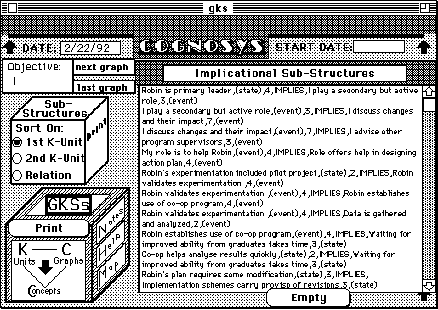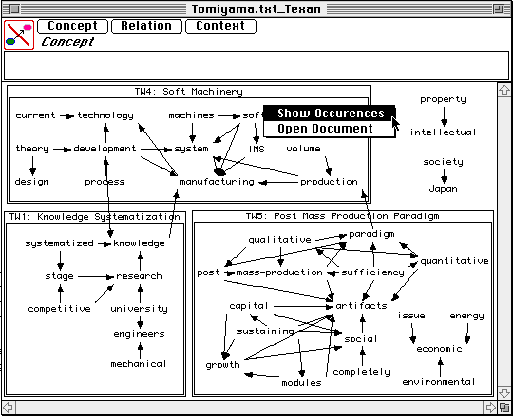
The concept maps shown in most of the examples so were all generated manually by a user entering data into the KMap graphic editor. The example of Figure 9 shows how inference may be used with formal semantic nets to generate additional nodes automatically. It is also possible to have concept maps that are in whole or major part automatically generated through some computational process. For example, Woodward's (1990) Cognosys tool for knowledge acquisition from text supports the analysis of protocols in terms of Graesser and Clark's (1985) linguistically derived "general knowledge structures" (GKS). Figure 17 shows text being split up in Cognosys and annotated with the GKS typology and relations.

Figure 17 Development of knowledge structures from interview text in Cognosys
Cognosys then exports this annotated text to KMap which automatically draws it as shown in Figure 18 as a set of nodes whose types correspond to the GKS types and relations, and whose content is the fragments of the text being analyzed. The algorithm for the graph layout was derived from one described by Watanabe (1989) which essentially uses a set of rules designed to minimize line crossings.

Figure 18 Automatic layout of knowledge structures from Cognosys in KMap
It is also possible to develop concept maps by fully automatic text analysis. Figure 19 shows a map generated automatically through analysis of the co-occurrence of words in sentences (Gaines and Shaw, 1994), a technique commonly used in information retrieval systems (Callon, Law and Rip, 1986). The document analyzed is one on The Technical Concept of IMS (Tomiyama, 1992) that played a major role in the design of the international Intelligent Manufacturing Systems (IMS) research program. The document is treated as a set of entities which are sentences whose features are the words they contain. Rules are derived using empirical induction in which the premise is that if one word occurs in a sentence then the conclusion is that another will occur. The graph shows the links from premises to conclusions derived in this way.

Figure 19 Concept map of GNOSIS project derived by text analysis
The initial output was a digraph consisting of one major connected component and some minor ones which correspond to significant topics such as intellectual property rights that did not directly relate to the socio-technical issues. The user noted that the major component itself consisted of 3 loosely connected sub-components, and added the context boxes shown to distinguish and name these parts. The significance of these parts is that they correspond to 3 of the 5 technical work packages (TW's) of the IMS GNOSIS research program. What is particularly significant is the missing work packages, TW2 concerned with product configuration management systems, and TW3 concerned with configurable production systems. These were added to the research program during its formation through amalgamation of interests with other potential proponents of IMS test cases. These packages link technically to the knowledge systematization activities on the left of Figure 19 but are neutral to the major issues of the IMS program on the right. Thus, the concept map produced by automatic text analysis provides insights into the underlying conceptual structure of the research program defined in the document analyzed.
A popup menu associated with each word provides hypertext links to a list of occurrences of that word in context, and to the original document. Additional links may also be added to other documents such as the progress reports on the associated projects, so that the concept map may be used as a project management tool.
gaines@cpsc.ucalgary.ca 22-Nov-95